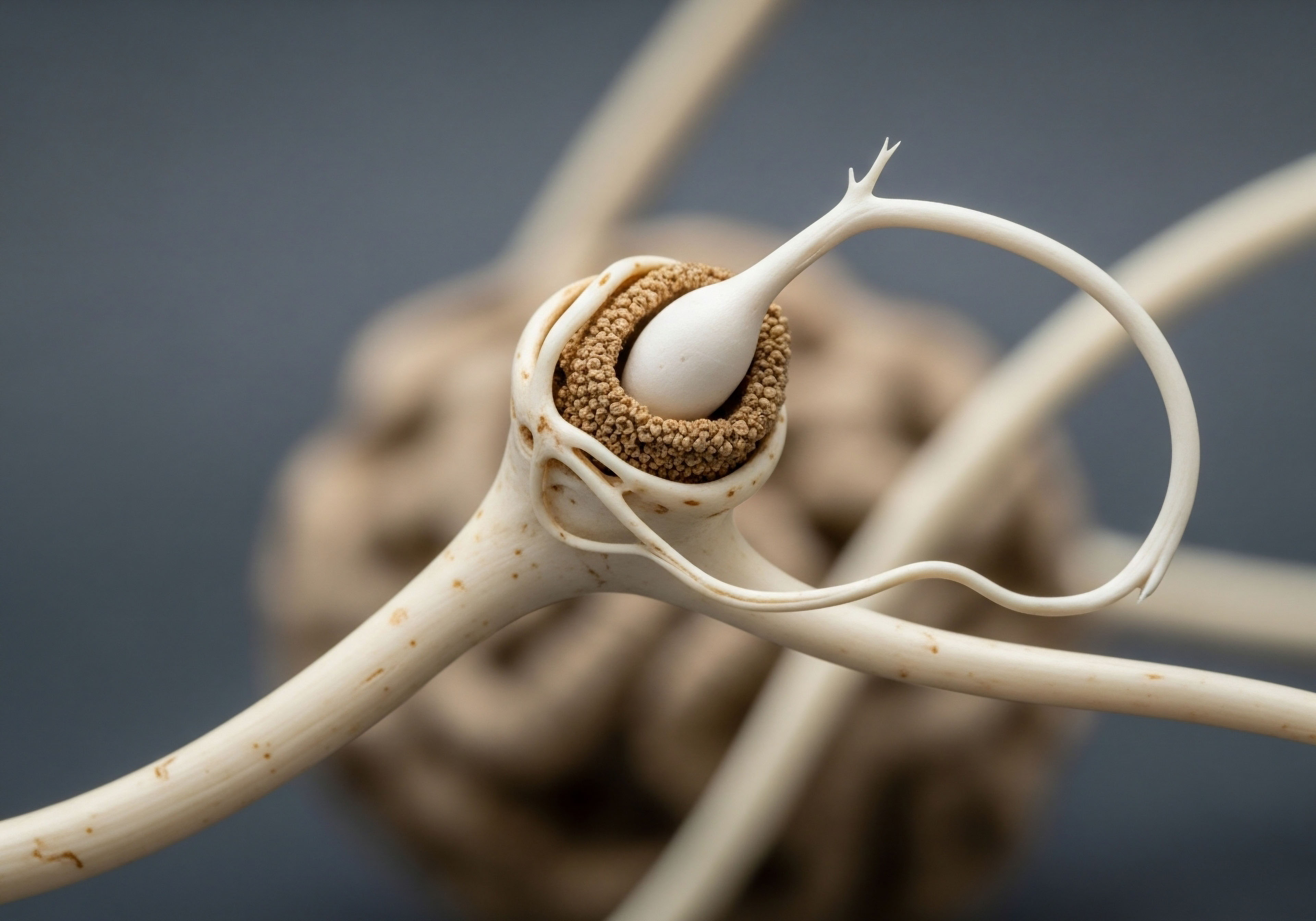

Fundamentals
There is a profound and often frustrating disconnect that can arise within our own bodies ∞ a moment when the desire you feel intellectually, the intimacy you wish to express, fails to translate into a physical, biological reality. This experience, a silent conversation where the mind makes a request the body does not answer, is a deeply human one.
It speaks to a disruption in the intricate communication network that governs our most fundamental functions. Understanding this signaling network is the first step toward restoring its fluency. The conversation begins in the brain, in a small, powerful region that acts as the master controller of our hormonal and instinctual worlds. PT-141 is a therapeutic tool that speaks directly to this control center, using the body’s own language to re-establish a connection that has been lost.
This peptide is a synthetic molecule designed to replicate the function of a naturally occurring hormone called alpha-melanocyte-stimulating hormone, or α-MSH. Within your body, α-MSH is part of a sophisticated signaling family known as the melanocortin system.
This system operates primarily within the central nervous system, carrying messages that regulate a host of vital processes, including energy balance, inflammation, and, critically, sexual function. PT-141 works by precisely targeting specific receivers, or receptors, within this system. Think of these receptors as specialized docking stations located on the surface of brain cells. PT-141 is the key designed to fit perfectly into two of these specific stations ∞ the melanocortin-3 receptor (MC3R) and the melanocortin-4 receptor (MC4R).

The Hypothalamus a Master Regulator
These crucial receptors are most densely concentrated in a region of the brain called the hypothalamus. The hypothalamus is the biological bridge between the thinking, feeling parts of our brain and the vast, automated chemical messaging network of the endocrine system.
It translates nerve signals into hormonal commands, making it the ultimate command center for thirst, hunger, body temperature, and the complex cascade of events that constitutes sexual response. When PT-141 binds to the MC3R and MC4R in the hypothalamus, it initiates a direct, localized neurological event.
It is a signal that tells the brain to begin the process of arousal from the top down. This is a fundamentally different approach compared to many conventional treatments that work on the body’s plumbing ∞ the vascular system ∞ at the peripheral level. PT-141 focuses on the source code of desire itself.
The activation of these hypothalamic pathways initiates a cascade of downstream signaling. It is akin to a command from headquarters that mobilizes specific divisions of the nervous system. This centrally mediated action is what makes PT-141 a unique tool in personalized wellness protocols.
It addresses the motivational and arousal components of sexual health, which are often the primary drivers of dysfunction. For many individuals, particularly as they navigate the hormonal shifts associated with aging, the issue is one of initiation and desire. The body’s physical capacity may be intact, yet the initial spark from the brain is diminished.
By working at the level of the hypothalamus, PT-141 helps to restore that initial, critical signal, allowing the rest of the body’s systems to respond as they are designed to.
PT-141 functions as a direct activator of the brain’s primary centers for sexual arousal.
This peptide’s interaction is an elegant example of biomimicry ∞ using a synthetic compound to replicate a natural biological process. The endocrine system is a web of interconnected pathways. The melanocortin system, where PT-141 acts, does not operate in isolation. It has functional links to the systems that regulate our sex hormones, our stress hormones, and our metabolic health.
Therefore, introducing an agonist like PT-141 has effects that ripple outwards, influencing the broader hormonal environment. Understanding these interactions is key to appreciating its full potential and integrating it wisely into a comprehensive health optimization plan. The journey to reclaiming vitality is one of understanding and addressing the root cause of biological disruption, and for many, that journey begins with the powerful signaling that takes place within the brain.


Intermediate
To truly appreciate the role of PT-141, one must look beyond its primary function and examine its place within the larger architecture of the human endocrine system. Its mechanism of action, centered in the hypothalamus, places it at the intersection of several critical signaling superhighways.
Two of the most important are the Hypothalamic-Pituitary-Gonadal (HPG) axis and the Hypothalamic-Pituitary-Adrenal (HPA) axis. These axes are the functional backbones of our reproductive and stress-response systems, respectively. They are complex feedback loops that the hypothalamus initiates and governs. The introduction of a melanocortin agonist like PT-141 can be understood as a targeted intervention that modulates the governor itself.

How Does Central Activation Circumvent Vascular Limitations?
The HPG axis is the hormonal cascade responsible for producing our primary sex hormones. The process begins when the hypothalamus releases Gonadotropin-Releasing Hormone (GnRH). This signals the pituitary gland to release Luteinizing Hormone (LH) and Follicle-Stimulating Hormone (FSH).
These hormones, in turn, travel to the gonads (testes in men, ovaries in women) to stimulate the production of testosterone and estrogen. Research indicates that the neurons in the hypothalamus that produce GnRH are situated in close proximity to neurons expressing melanocortin receptors. This anatomical arrangement suggests a functional relationship.
The activation of MC4R by agents like PT-141 appears to have a permissive or facilitatory effect on GnRH-releasing neurons, effectively influencing the very start of the sex hormone production line. This is a subtle but significant interaction. While Testosterone Replacement Therapy (TRT) directly supplements the end-product of this axis, PT-141 works upstream, potentially enhancing the central drive that governs the entire system.

The Neurotransmitter Bridge Dopamine
The experience of desire is a blend of hormonal readiness and neurological motivation. PT-141’s action beautifully illustrates this synergy. When it activates melanocortin receptors in the hypothalamus, one of the key downstream effects is the increased release of the neurotransmitter dopamine in specific brain circuits.
Dopamine is central to the brain’s reward and motivation system. It is the chemical messenger that reinforces pleasurable behaviors and drives us to seek them out. By promoting dopamine release in pathways associated with sexual behavior, PT-141 helps to bridge the gap between physical capacity and psychological drive.
This dopaminergic action is a critical component of its efficacy, particularly for individuals experiencing hypoactive sexual desire disorder (HSDD), where the primary symptom is a persistent lack of sexual thoughts and motivation. It effectively recalibrates the brain’s risk-reward calculation for sexual activity, enhancing the “wanting” component of libido.
This mechanism stands in clear contrast to other therapeutic modalities, offering a complementary approach. For instance, a male patient on a TRT protocol may have optimized testosterone levels, ensuring his body has the necessary hormonal substrate for physical function. Yet, he might still experience a lag in spontaneous desire.
In this scenario, PT-141 can act synergistically. The optimized testosterone provides the “fuel,” while the PT-141 provides the “ignition” signal from the central nervous system. This demonstrates a systems-based approach to wellness, where different protocols address different nodes within a complex, interconnected network.
| Feature | PT-141 (Bremelanotide) | PDE5 Inhibitors (e.g. Sildenafil) |
|---|---|---|
| Primary Site of Action | Central Nervous System (Hypothalamus) | Peripheral Vascular System (Corpus Cavernosum) |
| Core Mechanism | Activates MC3R/MC4R, modulating desire and arousal pathways. | Inhibits the PDE5 enzyme, increasing nitric oxide-mediated blood flow. |
| Primary Effect | Increases sexual desire and central arousal. | Facilitates and sustains penile erection. |
| Key Molecular Target | Melanocortin Receptors | Phosphodiesterase Type 5 Enzyme |
| Neurotransmitter Influence | Enhances dopamine release, impacting motivation. | Primarily vascular; secondary to central arousal. |
| Clinical Application | Addresses low desire (HSDD) and central causes of ED. | Addresses vasculogenic erectile dysfunction. |
The interaction with the HPA axis, our central stress system, is another layer of this complexity. The HPA axis also originates in the hypothalamus. Chronic stress leads to elevated cortisol, which can suppress the HPG axis, effectively dampening libido and reproductive function.
The parent molecule of the melanocortin family, pro-opiomelanocortin (POMC), is also the precursor to ACTH, the hormone that drives cortisol production. The melanocortin system is thus intrinsically linked to the body’s management of stress. While research is ongoing, modulating this system could have downstream effects on HPA axis tone, potentially buffering the libido-suppressing effects of chronic stress. This represents a frontier in understanding how we can use targeted peptides to restore balance across multiple, interacting endocrine systems.
- Initiation ∞ PT-141 is administered, typically via subcutaneous injection or intranasal spray, bypassing initial metabolic breakdown for rapid absorption.
- CNS Penetration ∞ The peptide crosses the blood-brain barrier to reach its target sites within the central nervous system.
- Receptor Binding ∞ PT-141 binds selectively to MC3R and MC4R on hypothalamic neurons.
- Intracellular Signaling ∞ This binding event triggers an intracellular cascade, leading to the activation of specific neuronal populations.
- Neurotransmitter Release ∞ A key outcome is the release of dopamine in reward and motivation circuits.
- Physiological Response ∞ The sum of these central actions translates into the subjective experience of increased sexual arousal and desire, which then facilitates downstream physical responses.


Academic
A granular examination of PT-141’s interaction with the endocrine system requires a focus on the molecular level, specifically on the distinct roles of the melanocortin-3 and melanocortin-4 receptors (MC3R and MC4R) and their integration with metabolic and neuroinflammatory pathways.
The therapeutic effect of PT-141 is a direct consequence of its agonism at these two receptors, yet their contributions are nuanced and synergistic. Understanding their individual functions illuminates the broader physiological impact of introducing a synthetic ligand like bremelanotide into the body’s internal communication network.

What Are the Implications for Metabolic Health?
The MC4R is perhaps the most extensively studied of the melanocortin receptors, primarily for its commanding role in energy homeostasis. It is a critical node in the leptin-melanocortin pathway. Leptin, a hormone secreted by adipose tissue, signals satiety to the brain by activating neurons that produce pro-opiomelanocortin (POMC).
POMC is then cleaved to produce α-MSH, the natural ligand for the MC4R. Activation of MC4R by α-MSH suppresses appetite and increases energy expenditure. Genetic deficiencies in this pathway are the most common cause of monogenic obesity in humans.
When PT-141, a potent MC4R agonist, is administered, it is essentially activating the same pathway that signals energy sufficiency. While its clinical application is targeted for sexual function, its engagement with this receptor means it is simultaneously interacting with the body’s central metabolic thermostat.
This interaction is dose-dependent and represents a significant consideration in its clinical use. The transient nausea sometimes reported as a side effect is likely mediated by this very pathway, as the systems governing satiety and nausea are closely linked. This metabolic dimension is a vital aspect of its endocrine footprint.

The Distinct Contribution of the MC3R
The MC3R, while also responsive to PT-141, plays a more modulatory role. It is expressed in similar brain regions as MC4R but also in areas associated with autonomic function and sodium balance. Some research suggests MC3R acts as an “autoinhibitory” receptor, helping to fine-tune the signals mediated by MC4R.
It appears to be more involved in regulating nutrient partitioning and preserving energy stores, particularly in states of caloric deficit. Its role in sexual function is less clearly defined than that of MC4R, but its co-activation by PT-141 likely contributes to the overall physiological response, perhaps by modulating autonomic tone or creating a permissive internal state for sexual activity.
The dual agonism of PT-141 at both MC4R and MC3R creates a more complete and potent activation of the central melanocortin pathways than a highly selective MC4R agonist might achieve alone.
Activating the melanocortin system for sexual response simultaneously engages deep-seated pathways governing the body’s metabolic state.
The intracellular machinery set in motion by PT-141 binding is a classic G-protein coupled receptor (GPCR) cascade. Upon binding, the receptor undergoes a conformational change, activating an associated Gs protein. This, in turn, activates the enzyme adenylyl cyclase, which catalyzes the conversion of ATP into cyclic AMP (cAMP).
cAMP acts as a second messenger, activating Protein Kinase A (PKA). PKA then phosphorylates a host of downstream targets, including ion channels and transcription factors like CREB (cAMP response element-binding protein). This phosphorylation cascade is what ultimately alters the neuron’s firing rate and gene expression, producing the desired physiological effect.
The increase in c-Fos immunoreactivity observed in hypothalamic neurons after PT-141 administration is a direct marker of this neuronal activation. This molecular pathway is the fundamental switch that PT-141 flips within the target cells.
| Parameter | Melanocortin-4 Receptor (MC4R) | Melanocortin-3 Receptor (MC3R) |
|---|---|---|
| Primary Function | Energy homeostasis, appetite suppression, sexual function. | Modulation of energy expenditure, inflammation, autonomic tone. |
| PT-141 Affinity | High affinity agonist. | High affinity agonist. |
| Location | Predominantly in the hypothalamus (paraventricular nucleus, arcuate nucleus). | Hypothalamus, limbic system, brainstem. |
| Downstream Signal | Primary driver of pro-erectile and pro-arousal signals. | Modulates and supports the primary signal; influences autonomic readiness. |
| Metabolic Role | Key mediator of leptin’s satiety signal. | Involved in nutrient partitioning and energy preservation. |
| Clinical Relevance | Primary target for PT-141’s effects on sexual desire. | Contributes to the overall therapeutic profile and side effect profile. |
Furthermore, the melanocortin system has well-documented immunomodulatory properties. The natural ligand, α-MSH, is potently anti-inflammatory. It can suppress the production of pro-inflammatory cytokines and promote the release of anti-inflammatory mediators. This action is often mediated through the melanocortin-1 receptor (MC1R), which is prevalent on immune cells.
While PT-141 has a lower affinity for MC1R compared to MC3R and MC4R, its interaction is not zero. Therefore, at a systemic level, administration of PT-141 could have subtle, yet potentially beneficial, anti-inflammatory effects. This connects the peptide’s function back to the principles of integrative medicine, where managing systemic inflammation is a cornerstone of promoting overall health and optimal endocrine function.
Chronic low-grade inflammation is known to suppress HPG axis function and contribute to metabolic dysregulation. A therapy that can simultaneously enhance central arousal while potentially mitigating inflammatory tone represents a powerful, systems-level intervention.
- Direct Neuronal Activation ∞ Studies show PT-141 administration leads to increased c-Fos expression in key hypothalamic regions, including the paraventricular nucleus (PVN) and the medial preoptic area (mPOA), confirming direct activation of neurons critical for sexual function.
- Synergy with PDE5 Inhibitors ∞ Clinical data indicates that co-administration of intranasal PT-141 with sildenafil results in a significantly longer duration of penile rigidity compared to sildenafil alone, demonstrating that central and peripheral mechanisms can be combined for an enhanced effect.
- Dopaminergic Pathway Engagement ∞ Microdialysis studies in animal models confirm that melanocortin agonists increase dopamine release in the nucleus accumbens, a key brain region for reward and motivation, providing a mechanistic basis for the observed effects on desire.

Can PT-141 Influence the Bodys Stress Response?
The intricate relationship between the melanocortin system and the HPA axis warrants further exploration. The precursor molecule, POMC, is the source of both α-MSH (the natural agonist for the receptors PT-141 targets) and Adrenocorticotropic Hormone (ACTH), the direct stimulus for cortisol release from the adrenal glands.
These two signaling molecules are often released under similar conditions, such as stress. However, they can have opposing effects on behavior. While acute stress and ACTH release can trigger arousal (a ‘fight or flight’ response), chronic HPA activation and high cortisol levels are profoundly suppressive to the HPG axis and libido.
By selectively activating the MCR pathway with PT-141, it may be possible to stimulate the arousal circuits while bypassing the full-blown ACTH-cortisol stress cascade. This could represent a mechanism for uncoupling arousal from the negative consequences of chronic stress, offering a therapeutic pathway for individuals whose libido is suppressed by HPA dysregulation. This selective activation within a shared precursor system is a testament to the elegance and complexity of neuroendocrine control.

References
- King, Shari. “PT-141 (Bremelanotide) for Sexual Dysfunction ∞ Clinical Guide for Physicians.” eNavvi, 20 May 2025.
- “What Is PT-141? Mechanism, Benefits, and How It Works.” Invigor Medical, 1 July 2025.
- Hadley, M. E. “PT-141 ∞ a melanocortin agonist for the treatment of sexual dysfunction.” Annals of the New York Academy of Sciences, vol. 1040, 2005, pp. 484-91.
- Martin, W. J. et al. “Melanocortin Receptors, Melanotropic Peptides and Penile Erection.” Current Topics in Medicinal Chemistry, vol. 7, no. 11, 2007, pp. 1137-44.
- “PT-141 (Bremelanotide) ∞ A Comprehensive Guide to Treating Sexual Dysfunction.” Regenerative & Anti-Aging Medicine of arizon, 15 March 2025, YouTube.

Reflection
The information presented here provides a map of the complex biological territory that governs desire and arousal. It shows how a single molecule can interact with the brain’s most powerful control centers, influencing not just one specific function, but also touching upon the systems that manage our energy, our stress, and our hormonal milieu.
This knowledge is a powerful tool. It transforms the conversation from one of isolated symptoms to one of integrated systems. Your body is a coherent whole, a network of constant communication. Understanding the language of that communication is the foundational act of reclaiming your own vitality.
Consider where the signals in your own system may be disrupted. This understanding is the starting point for a more informed, personalized, and empowered conversation with a clinical professional who can help you translate this knowledge into a protocol that restores your unique biological harmony.

Glossary

melanocortin system

central nervous system

sexual function

endocrine system

hypothalamus

mc4r

nervous system

hpg axis

melanocortin receptors

dopamine release

hypoactive sexual desire disorder

hpa axis

pro-opiomelanocortin

bremelanotide




